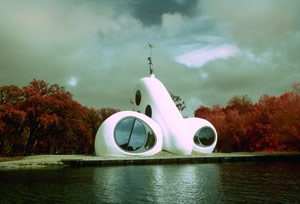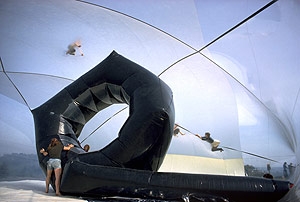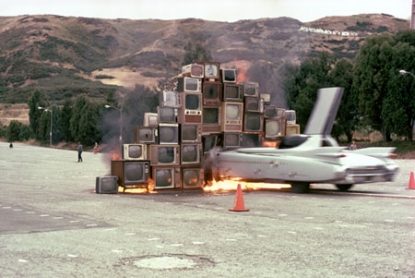
Ant Farm, Media Burn, July 4, 1975; performance at the Cow Palace, San Francisco, CA. Photo: © John F. Turner
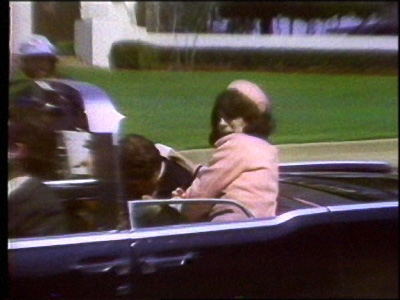
Ant Farm and T.R. Uthco, The Eternal Frame, August 1975, performance, Dealey Plaza, Dallas. Photo: Chip Lord.
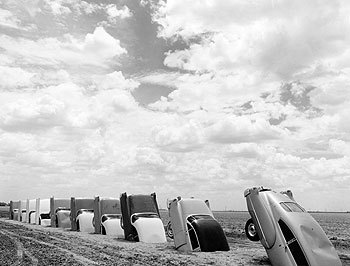
Ant Farm (Lord, Marquez, Michels), Cadillac Ranch, 1974; site-specific installation, Amarillo, Texas. © Ant Farm
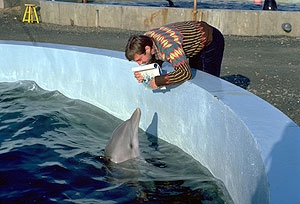
Doug Michels explaining the Dolphin Embassy to a dolphin in a tank, 1977; Surfer's Paradise, Queensland, Australia. Photo: Ant Farm
Feature: Essays
Sex, Drugs, Rock and Roll, Cars, Dolphins, and Architecture
Stretcher continues our series of excerpts from the Ant Farm 1968 - 1978 exhibition catalog with this spirited essay by Michael Sorkin. Constance Lewallen’s introduction to Ant Farm can be viewed here. Ant Farm 1968 - 1978, shows at the Berkeley Art Museum through April 25.
– The Editors
Of the true faiths that multiplied in the sixties, the most subsuming was trinitarian. As a basis for cultural production, sex, drugs, and rock and roll was surely a more stimulating formula than the anhedonic strictures youth was struggling so hard to overturn. The times, after all, were not purely about rupture but also about rapture, about submitting the cultural and physical landscape to the revaluing of altered vision.
That vision was diverse. The rainbow world of acid and magic mushrooms, the liberated coupling, the gentleness and universal collegiality, the disdain for materialist striving, the ubiquitous sound track, the Aquarian strain—all contributed both to the project of invention and to the larger epistemology of seeing. Among the watershed events in this history, the shock that greeted Bob Dylanís switch to electric guitar in 1965, yanking folk music into the age of rock and roll, symbolized the paradigms at play.
The move beyond Joan Baez, Woody Guthrie, and Leadbelly was not just acoustic but deeply political, combining electric tech with new styles of joy, eschewing suffering for abandon, and begging the old Brechtian question of a mass authentic. When Dylan took the stage that fateful night at the Newport Folk Festival, architecture was also at a moment of tremendous perplexity. The reductively styled mass architecture of modernism was in disrepute, not simply for its boring formal endgame but, more importantly, for the ravages wrought in the name of its Cartesian lusts, the purifying orders of urban renewal and the pat, thoughtless verities of the suburban consumption machine. Architectureís rebellious youth declined to sign on to the project and began to search for alternatives in the cultural grab bag of the sixties. Some chose the resistance of advocacy planning and community defense, carrying on the identification with the oppressed that was also the legacy of folk and the blues. Some repaired to the dour climes of historicism. Many took to the woods, back to nature, to study communitarianism and to live a life of virtuous simplicity. Others wondered about the architectural equivalent of rock and roll. From this matrix, Ant Farm emerged in our annus mirabilis, 1968.
It wasn’t just the music that was inspirational; the rock group also emerged as a model of practice for Ant Farm and others, reflected in the organizational routines (sleep late, drop acid, brainstorm, and riff), the spirit, the road trips, and the nomenclature: calling their collaboration “Ant Farm” immediately signaled that the work would be of a different order than that produced under the gray-flannel imprimatur of a firm such as Skidmore, Owings, and Merrill (whose button-downomie Ant Farm so brilliantly parodied in the deeply deadpan Chevrolet Training Film [1978–81], done with Phil Garner). To stretch the analogy, the Ant Farm sensibility—synthesized in postñSummer of Love San Francisco—was a combination of the Beach Boys and the Grateful Dead. From the Dead came the trippy spontaneity and zapped transcendence; from the Beach Boys, the genuine fondness for pop culture—car culture in particular—and an incredibly smooth technique.
If Ant Farm was the Beach Boys (albeit a Beach Boys in which everyone was Brian), Archigram, in England, was the Beatles, and, I suppose, Frank Lloyd Wright was Elvis, a synthesizing genius, protean, multiply parodied, the King (and the Dad). The role of the Rolling Stones was shared by a variety of European architects, especially the group of Austrians including Haus-Rucker-Co. and Coop Himmelblau, with their scintillating but ultimately sour aestheticizations of rage. Ant Farm was not content to develop its own traditional formalism. The group well understood that the object is nothing without its performative aura, and their high-theatric events Media Burn (1975) and The Eternal Frame (1975) were characteristic of their edgy hilarity and deliriously twisted appropriations.
Indeed, the brilliance of Ant Farm’s irony was the guarantor of their integrity. They were—and are—among the preeminent comedians of architectural culture—not Serlio parsing the mood of the city, but Lenny Bruce or Rodney Dangerfield: “Take my architecture . . . please.” Genius practitioners of the carnivalesque, the Rabelaisian world that Bakhtin so persuasively associates with insubordination and the rejection of cultural constraint, Ant Farm engaged the most powerful aspect of the joke: the possibility of splicing things that in conventional atmospheres would be considered impossible to join.
In the expanded field of their enthusiasms—the homage paid to both Harley Earl, the avatar of baroque automobile stylings, and Bucky Fuller, the Dymaxion man (and subject of a bizarre and hilarious “kidnapping” by the Ants)—the group sought to unite apparent disparity through genuine generosity of affection. Countercultural bricoleurs, they created a graphic and architectural style that joined the curvaceous enthusiasms and future lust of Norman Bel Geddes with the funky delineation, sexual obsession, and dark worries of R. Crumb. Theirs was an architecture of an era in which comic books aspired to the weight of Dostoyevsky.
Bifurcation is the manufactury of surreality, and Ant Farm must be honored for being ever true to the surreal. Theirs, though, was a post-Surrealist surreality: they revered the technique but not the anxiety. The French Surrealists fetishized the unconscious and sought authority in the weird commonplace of dreams. But there was always something effete about them: on the one hand, the purest strain of narcissism, and on the other, a snoot-cocking at the artistic establishment. But the Surrealists were self-identified, above all, with the world of art, and their mediums were those of the artists they sought to overthrow. Ant Farm was never snobbish, recognizing that dreams were chemical and that fun was the ultimate affront to the authorities who preferred youth to be quiescently shipped off to Vietnam.
The postmodernist architecture that emerged during Ant Farm’s fateful decade represented—inter alia—a post-televisual surreal. Watching television, the most powerful everyday experience of surreality ever devised, was formative of the cultural outlook of anyone growing up in America in the fifties and sixties. With its endless sequence of splicings of commercials and programs and channel switchings, television was and is the ultimate “exquisite corpse,” a juxtaposition engine that produces a completely weird artifact at any given watching. Postmodern architecture in all its branches was predicated on the idea of a postuniversal style, the idea that style could be freely borrowed and that creativity lay in a recombinant operation, the production of sequential freaks.
Unfortunately, most of the postmodernist heroes lacked the courage (or the brains) to truly pursue the insight, their own bad taste masquerading as populism or theory. They were thus unable to truly participate in culture’s seismic shifts as they stood on the sidelines focusing their Nikons. Thus, the contributions of postmodernist architects from Robert Venturi to Philip Johnson to Rem Koolhaas are notable less for their modest formal inventions than for their “ironic” denunciations of the larger field of culture to justify their own conceptual embrace of the worst excrescences of corporatism—branding and image control, a resort to the authority of historical forms and practices, cynical elitism, and sell-out.
Ant Farm would have none of this and besieged the dopiness of the profession with their lusty nonconformity. One must remember that “freak” carried a positive valence in those days. Freaks opposed the regimentation of consumption and celebrated the possibility of self-invented singularity. Their defense of the creativity of difference continues to be a bracing model for architecture and its politics. In today’s climate—in which the social irrelevance of architects is exacerbated by a retreat into formalism, arcane theorizing, and supine co-optation—the idea of a practice motivated simultaneously by private enthusiasm and public critique is tonic.
It would be a mistake, though, to think of Ant Farm simply as canny gonzos. They were genuine researchers, and their contribution not only anticipated the strategic polemics of the current “Dutch School,” with their weighty, resistibly stylish tomes, but set the agenda for contemporary research in environmentalism, advanced building technologies, electronic globalization, public art and space, and postindustrial flows. That this research flourished outside conventional academic sanction was also the realization of a desire to see knowledge loosed from privilege. The ultimate avatar of this style of inquiry was surely our great flower-power Diderot, Stewart Brand, whose Whole Earth Catalog literally and figuratively encapsulated the potentially liberatory capacity of things, wresting them from the authoritarian style of the market and the hyperconsumption of the suburbs. The Ants’ lovely Automerica (1976) was a clear precipitate of this inventory of the good stuff.
That subject matter was no coincidence. The Ants’ project grew from a foundational enthusiasm: cars, our national icon. The reasons are overdetermined. To begin, the Ants were all boys whose susceptible youth was spent in the 1950s, the high-water mark of the American car. Those were the days of exponential growth, of a dizzy potlatch of styling, weight, fuel consumption, pollution, lethality. It was the era in which the car became the instrument and the emblem of the American project for the reorganization of planetary space, the endlessness of freeways and suburbanism, the Ozzie and Harriet world of consumer docility and the strange constrained pleasures of the brand—how did they persuade millions to eat Chef Boyardee ravioli from a can? The fifties were that time when “What’s good for General Motors is good for the country” became our national mantra.
But there’s necessarily ambiguity in the automotive cathexis. The car both symbolized and enabled a pure cultural and physical mobility that lay at the core of the cultural desire of sixties youth. It was an agent of expression, the emblem of class, rebellion, creativity, and freedom. The counterculture sought access to the diversity of cultural experience—whether in the romance of African American culture, the Thoreauvian idyll of nature, or the spirituality of all those pilgrimages to the East—and was confident that an authentic experience of the other was simply a matter of hanging out. For the first generation in which wanderlust had truly continental—and intercontinental—dimensions, the car became the means of access to an unfolding space.
The ultimate countercultural vehicles were Volkswagen vans and converted school buses (e.g., the psychedelic transport of Ken Kesey and the Merry Pranksters), self-effacing but communal vehicles designed to enable the gathering of the tribe, but also, critically, genuinely mobile homes for the realization of the wildest dreams of hippie nomadology. Prototypes of a universal architecture, a gestating idea that had vexed modernity from the get-go, alternative automobilization outdid the hemmed-in thinking of conventional modernity by freeing itself from the constraint of site. Ant Farm’s inflatables—portable, affordable, cut loose from the walls of the academy—were the extension of the car by other means.
Parallel to the investigation of “free” celestial-terrestrial space, Ant Farm worked to imagine and articulate the relationship of such a liberated style of physical space with the mesh of media that were simultaneously respatializing the planet. Moving beyond machine-in-the-garden basics, Ant Farm invested in a Hefneresque vision of private multimedia environments—such as their 1971 Newman Media Studio—and in media “software”—the videos, performances, and cautionary fables that served as both investigation and critique of a burgeoning phenomenon.
The sense of the complex relationship of these social and spatial networks gives the work of Ant Farm unusual prescience and links their efforts across a variety of media. TVTV (Top Value Television) was typical in that its core of electronic communication was supported by the groovy roaming van, the instrument for projecting the Ants into the space of observation and encounter, the territory for their own mediations. The insistence on the centrality of the physical design of the roaming home was advanced still more elaborately in the Dolphin Embassy project (1974ñ78). Whatever one thinks about the importance of interspecies communication, the Dolphin Embassy was both a completely realizable scheme and a recapitulation of the ideology of the movable feast, here at the service of an encounter with the most priapic of beasts.
Stylishness was always central as both a strategy and a conundrum. For Ant Farm, customization was the vehicle for insinuating radical difference into the market, the locus at which folklore and mass culture merged, and an analogue for an architecture-to-be. Their image bank is loaded with loving variations on the conventional automotive envelope, and they were certainly in the right place to study the subject: California was an incubator of the car as an artistic medium, the recontourings of standard product into private fantasy. Whole schools of customization flourished, ranging from the iconic low-riders of Mexican American culture to the panoply of wacked hippie refurbishments, those shingled vans now composting in the woods outside Mendocino.
Ant Farm’s eternal emblem is Cadillac Ranch (1974), that primal icon of gathering. Its Stonehenge quality precisely suggests the work of a cult willing to go to absurd lengths in worship of an object of totally strange character. The learned Darwinian assembly of the ascending ontology of the tailfin is at once a living catalog of a transcendent artifact and a sly riff on the utter meaninglessness of consumption-driven style. The interring of the cars—the immobilization that turns them into architecture—suggests the inevitable doom of the entire project of the automobile.
Ant Farm’s series of car concerts and the Media Burn Phantom Dream Car continued to expand the car’s expressive, self-critical range. A Caddy customized into a hyperconcept car, the Phantom Dream Car was designed to enable a short-lived event symbolizing its own futility (being driven into a flaming wall of televisions) and to mock received futurist fantasies of speed and the glories of mass destruction. However, Ant Farm’s most biting piece of auto critique, and their most brutally direct mating of form and place, was their reenactment of John F. Kennedy’s assassination at Dealey Plaza in Dallas for The Eternal Frame. This dark, affectless event (would anyone presume to reenact the fatal crash of Dodi and Di?) was not simply a provocation addressed to the necrophilic frenzy of the assassination industry and its endless flow of conspiracy theories, mawkish images, and premature hagiography; it was about the car, the Lincoln Continental and its fatal backseat, evoking Ed Kienholz’s own legendarily fetid groping of this site. Sexualized in the fifties as the make-out room for millions, the backseat had been transformed into the cockpit for the politics of murder via the Zapruder film, the omega of low-budget American porn.
Which brings us to sex. Ant Farm, in the libidinous blanket of their gaze, made heroic contributions to the sexualization of architecture, long before it was taken up by academics for its revealing ramifications of difference. This was both a product of the amazing liberations of the sixties and a sign of the eruption of the post-Freudian, postñNorman O. Brown atmosphere that identified our daily relations as suffused with sex, whatever the nature of the acts. Ant Farm was thus squarely post-Kinsey (Sexual Behavior in the Human Female and Sexual Behavior in the Human Male were surely the Whole Earth Catalog of sexuality), in the sense that their professionalism dilated enthusiastically on the precise dimensions of sexual behavior. From Doug Michels’s legendary coupling with a girlfriend under an American flag outside the Paris Biennale in Make Love, Not War (1969), to the immortal House of the Century (1971ñ73), iconographically poised somewhere between oikema and schnozz, to the abiding fascination with dolphins, known for their cross-species appetites, to their high-testosterone-car-fetish-displaced male sexuality, theirs was an architecture that can be truly said to have gotten it on.
Architecture, invariably social, was not simply politically but also conceptually fraught during the Ant Farm era. However, that Ant Farm’s work happily and continuously owned up to the rubric and practice of architecture is central to its heft. The Farmers’ indelible contribution was not abandoning the centrality of the idea of building, despite the assaults on its meaning resulting from its dissipation into the “expanded field” of landscape, art, and consumption. Here is the root of the Ants’ abiding optimism. Despite the irony in which much of their work is shrouded, the project was always one of both social and physical reconstruction and never ceased its flirtation with the practical. Such playing it relatively close to the bone is the key to the idea of an oppositional architecture. Given conventional architecture’s locked embrace with the power that produces it, the contest must be fought in the formulation of alternatives with a chance of replacing the mire of the present.
Walking the fine line between the impossible and the practical was Ant Farm’s stock-in-trade. Beginning with their first inflatable projects, Ant Farm rode the wave of political and cultural enthusiasms that sought an architecture that could be realized outside the intentions of the Man. The idea of the inflatable, lightweight and nearly immaterial, joined notions of nomadology and ephemerality to create spaces that were freely habitable by routines outside the cellular orders of offices and families. Supported by air, and by tiny and benign technologies of convenience (often embodied in magical hi-fi-like consoles), the inflatables were at once gentle and evocative of the fragility of the threatened biosphere. The dome, recurrent in their work from the inflatables to Convention City (1972) and Freedomland (1973), was a crucial totem of the liberty of undifferentiated enclosures to support free styles of inhabitation. Hostile to hierarchies and phallomorphologies, the dome was a stab at the death of patriarchy. Finally, responsible propagandists, Ant Farm also authored the 1970 Inflatocookbook to share and promulgate both technology and vibe, the pneumatology of freedom. The point wasn’t simply form, but access too.
Looking back at the amazingly fertile oeuvre of the Ants—produced in a ten-year sprint that would have left lesser artists burned out for life—one is overwhelmed by their vision and their generosity, their interventions in the range of practices and issues that set the contemporary agenda for architecture. Performance, video, public sculpture, architecture, and polemic were all wielded with huge skill and massive aplomb. The Ants’ rapier sliced and reconfigured mass culture, the automobile, environmentalism, professionalism, and the shifting fields of architectural and artistic practice, and did it with hilarity, discipline, brilliance, and beauty. And, shunning the geriatric antics of rock bands living on their endless reunion tours, they snuffed their candle when it was still burning bright. Long live the Ants!
The catalog for Ant Farm 1968-1978 is supported by a grant from the Graham Foundation for Advanced Studies in the Fine Arts and is published by the University of California Press.
The catalog and exhibition have also been made possible by The Judith Rothschild Foundation, in recognition of Doug Michels; the National Endowment for the Arts; Rena Bransten; Marilyn Oshman; the Consortium for the Arts at UC Berkeley; the Windfall Foundation; and Joan Roebuck. Special thanks to Robert and Caroline Michels.
Ant Farm 1968-1978 is organized by the University of California, Berkeley Art Museum and Pacific Film Archive and is cosponsored by the College of Environmental Design and Department of Architecture.

